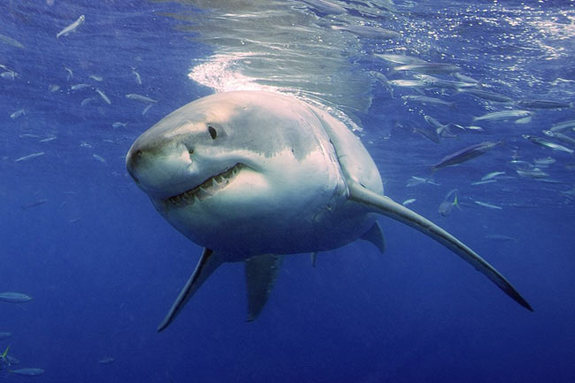
Travels of Pregnant Great White Sharks Revealed

For the first time, migrating great white sharks have been tagged and their movements around the oceans tracked for years, as opposed to the few months they have previously been tracked, according to a researcher.
Scientists used special satellite tags that tracked several sharks from a specific great white population for up to three years off the coast of Mexico. The study found that adult female sharks complete a two-year breeding cycle and avoid male sharks whenever possible, said study author Michael Domeier, a researcher and the president of the Marine Conservation Science Institute.
Published recently in the journal Animal Biotelemetry, the study followed four female great white sharks from their mating grounds off Mexico's Guadalupe Island until they returned 24 months later, Domeier said. During the first 18 months, the females followed an ambling path through the open ocean, he said.
They then arrived in off Baja California to give birth to shark pups, putting themselves at risk of running into shipping traffic on their voyage along the shore, the study found.
"During the time the females are giving birth along the Baja Peninsula they are exposed to an array of commercial fishing activities that put them at risk," Domeier told OurAmazingPlanet in an email. "Of course, the baby white sharks are at even more risk since they spend the first years of their life in coastal waters and their small size makes them even more susceptible to capture." [Image Gallery: Great White Sharks]
Once the young sharks are born, the females return to Guadalupe Island to mate again.
The study found a high prevalence of bite marks on the sharks. Male sharks "bite the head, flank or pectoral fin of females during the mating ritual, but certainly these sharks are biting each other out of aggression as well," Domeier added. "Males may be battling it out for access to females or preferred hunting grounds."
Sign up for the Live Science daily newsletter now
Get the world’s most fascinating discoveries delivered straight to your inbox.
While the females return to mate every two years, the males only return every other year. When they're not mating, both males and females may range as far afield as the waters off Hawaii, Domeier said.
The researchers tag the great white sharks by affixing the device to the tip of the animal's dorsal fin, during which time they are very close to the predators.
"It's surreal and humbling," Domeier said. "It is also stressful since the shark's life is in our hands during the short time it takes us to capture and tag each individual."
Email Douglas Main or follow him @Douglas_Main. Follow us @OAPlanet, Facebook or Google+. Original article on LiveScience's OurAmazingPlanet.










